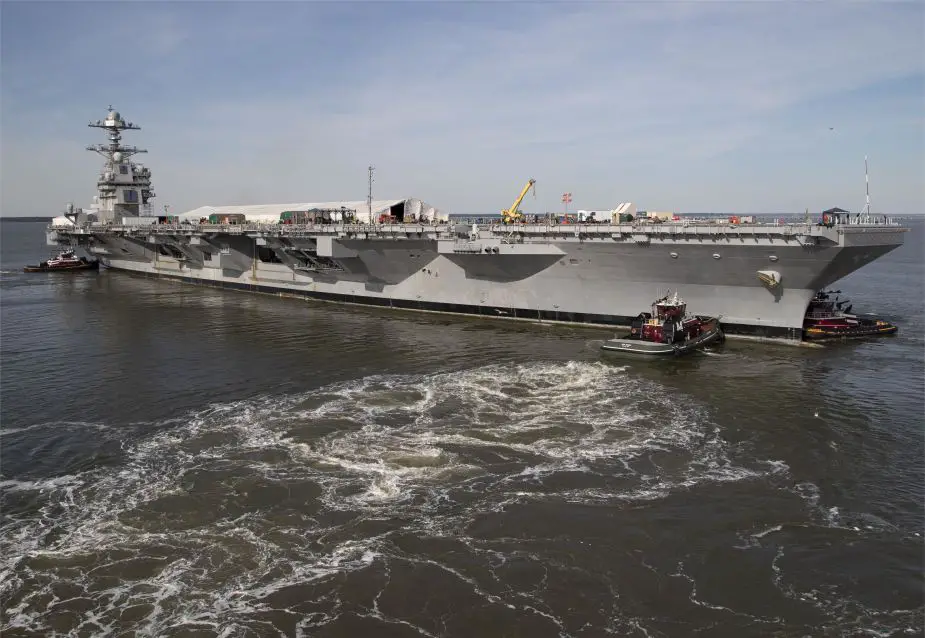Breaking news
USS Gerald R. Ford aircraft carrier of US Navy propulsion plant reaches completion.
U.S. sailors assigned to USS Gerald R. Ford’s (CVN 78) Reactor Department and Huntington Ingalls Industries-Newport News Shipbuilding (HII-NNS) technicians recently completed a production milestone by reaching the propulsion plant completion date (PPCD), July 22, 2019.
 The aircraft carrier USS Gerald R. Ford (CVN 78) is maneuvered by tugboats in the James River during a turn ship evolution. March 17, 2019. (Picture source US Navy)
The aircraft carrier USS Gerald R. Ford (CVN 78) is maneuvered by tugboats in the James River during a turn ship evolution. March 17, 2019. (Picture source US Navy)
After more than 12 months of maintenance and repairs, the Navy accepted re-delivery of the propulsion plant upon PPCD, marking significant progress in Ford’s post-shakedown availability (PSA), and driving the ship closer to getting back out to sea.
Troubles with Ford’s propulsion system were first noted while conducting trials at sea in January 2018, when the crew identified a component in the propulsion train that was operating outside of design specifications. HII-NNS determined that the issue was due to a manufacturing defect (not improper operation) in the propulsion train component that affected the same component in the other propulsion trains.
In May 2018, three days into a planned underway to continue testing and evaluation, the ship experienced another propulsion plant issue associated with a design modification which resulted in Ford returning to homeport. Once in Norfolk, adjustments were made and the ship returned to sea later that month.
Ford returned to port June 7, 2018, following the successful completion of all required ship testing during its at sea period. During these tests, the Navy and Newport News Shipbuilding determined the required steps to correct the manufacturing defects would be fully corrected during Ford’s PSA.
As a first-in-class ship, some issues were expected, giving rationale for the long periods of testing and evaluation. Ford was tasked with conducting critical test and evaluation operations that are meant to identify construction and design issues. Ford’s propulsion issues weren’t with the nuclear reactors themselves, rather the issues resided in the mechanical components associated in turning steam created by the nuclear plant into spinning screws that propel the ship through the water.
During Ford’s PSA, Sailors worked alongside HII-NNS shipyard technicians to complete 400,000 man-hours of maintenance and production work to reach this important milestone, but Ford Sailors are still working hard every day to get the ship ready to join the rest of the fleet and return to sea to complete additional aircraft carrier qualifications.
Since first getting underway on April 8, 2017, Ford has safely conducted 10 underway evolutions and has completed all of the testings that was required prior to beginning the ship’s PSA last summer. Collectively, this has brought a tremendous amount of knowledge to the Ford-class program. The lessons learned, corrections, and design changes can be integrated in the construction of the next ships in the Ford-class of aircraft carriers.
The Gerald R. Ford-class is the latest generation of aircraft carrier of US Navy, a replacement class for Enterprise and Nimitz-class aircraft carriers The lead ship, Gerald R. Ford (CVN 78), was commissioned in 2017.
The Gerald R. Ford is the first aircraft carrier designed with all electric utilities, eliminating steam service lines from the ship, reducing maintenance requirements and improving corrosion control. The new A1B reactor, Electromagnetic Aircraft Launch System (EMALS), Advanced Arresting Gear (AAG), and Dual Band Radar (DBR) all offer enhanced capability with reduced manning. The Gerald R. Ford-class is designed to maximize the striking power of the embarked carrier air wing. The ship's systems and configuration are optimized to maximize the sortie generation rate (SGR) of attached strike aircraft, resulting in a 33 percent increase in SGR over the Nimitz- class. The ship's configuration and electrical generating plant are designed to accommodate new systems, including direct energy weapons, during its 50-year service life.
The Gerald R. Ford aircraft carrier is capable of carrying up to 90 aircraft, including the F-35 Joint Strike Fighter, F / A-18E / F Super Hornet, E-2D Advanced Hawkeye, EA-18G Growler electronic attack aircraft, MH-60R / S helicopters, as well as unmanned air and combat vehicles.


























